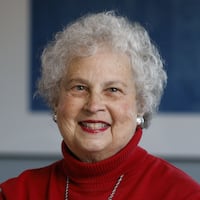“I’ve never been able to do enough fund-raising to keep the place alive,” Jennewein said. She said that although the CADC has had great supporters and board members over the years, this “task has been daunting without proper staff and funding.”
Eva Buttacavoli, executive director of the Dayton Visual Arts Center — an organization for artists and a gallery — said the region’s art community talks about sustainability of artists and arts programs all the time.
“This is a particularly brutal blow, as the CADC represented just what artists need to keep living and working here — a professional venue to market and sell their work,” Buttacavoli said. “But for a city whose government and business leaders brag about having such a rich arts and culture scene, there is a gap in supporting that claim. We have to launch from a community where supporting our artists/buying a work of art — from $40 to $400 — is not a luxury but is an investment in our city’s collective mission for vibrancy, quality of life and cool factor.”
Tracing its roots
The gallery started taking shape in 2006 when Cannery developers Beth Duke and Dave Williams came up with the idea of putting an art gallery in their building of residential lofts.
“It was a great concept,” said Jennewein, an artist best known for her large abstract contemporary paintings and functional art furniture. “We had 10,000 square feet and 40 artists. It was designed to be a business within a business — each artist leased their own studio.”
The idea was to create an art community downtown. Originally Jennewein was an employee of the building; eventually, the decision was made to turn the gallery into a non-profit organization, Can Opener. Two years ago when the Cannery building changed ownership, Jennewein sought a new location and ended up at St. Clair and Fourth with 3,800 square feet of space. The building is owned by Alan Lindy of Philadelphia.
Jennewein said the move caused an identity crisis, particularly with the name change. But the classes, art shows and programming continued in the new location.
“We have opened our doors and opened our gallery and services for free to many community-minded people to help improve our city,” said Jennewein, who said groups such as Generation Dayton, Ted Talks, Downtown Dayton Partnership, Noble Circle and the Chamber of Commerce and universities have taken advantage of that offer over the years.
With Jennewein’s help, ideas including First Friday art showcases came to fruition, as well as other efforts that have benefited the community.
“Dayton people are hungry to see art and Christy has had ongoing classes, and art therapy programs for oncology patients. She invited people to bring in furniture that has been important in their lives and she helped them refurbish it,” said John Landsiedel, an artist who does large-scale abstract paintings and pop art and who has been associated with the Cannery gallery since its inception.
“Although we’re closing the gallery, we’ll be doing more mobile art,” he continued. “We’ve been putting art in offices — today we’re going to flood Dr. Barry Taylor’s office in Oakwood with art that will be in the exam rooms, his offices and in the reception area. The Dayton Dental Collaborative on Far Hills has more than 25 large artworks. And we’ll be taking over the top floor of the McCormick Building across from the Fifth Third Field later in June and will do a mobile exhibit of art.”
Jerri Stanard, founder and executive director of K-12 Gallery, said her gallery’s recent move will allow it to become a community artist center with plenty of space and a collaborative environment for groups like Jennewein’s.
“ We can make bigger things happen when we collaborate,” Stanard said.
CADC is currently holding a moving sale. For more information, visit www.canneryarts.com or call (937) 313-9883.
About the Author

